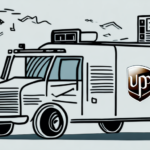How to Request a UPS Shipping Charge Correction for Ground Delivery
Shipping costs are a significant part of your business expenses, especially if you rely heavily on UPS for your deliveries. Occasionally, you might find discrepancies between your expected shipping costs and the invoices you receive. In such cases, requesting a UPS Shipping Charge Correction can help you recover overcharges and ensure accurate billing. This guide provides a comprehensive overview of the process, ensuring you handle charge corrections effectively and maintain control over your shipping expenses.
Understanding UPS Shipping Charges
Before initiating a charge correction, it's crucial to understand how UPS calculates its shipping fees. UPS shipping charges are influenced by various factors:
- Package Weight: The actual weight of your package.
- Package Dimensions: Length, width, and height, which contribute to dimensional weight.
- Destination: The delivery location, with different rates for domestic and international shipments.
- Shipping Speed: Options range from Ground to Next Day Air, each with varying costs.
- Extra Services: Additional services like insurance, signature confirmation, and special handling.
Understanding these factors helps you anticipate your shipping costs accurately. For more detailed information, visit the UPS Shipping Charges page.
One critical component is dimensional weight. UPS uses dimensional weight to charge for packages that are large but relatively light, which ensures that the space a package occupies is factored into the cost. Accurately measuring and weighing your packages can prevent unexpected charges based on dimensional weight.
Common Reasons for Incorrect Shipping Charges
Even with careful preparation, shipping charge discrepancies can occur. Common causes include:
- Human Error: Mistakes in entering package details such as weight, dimensions, or destination.
- Incorrect Package Weighing: Using inaccurate scales can lead to overcharging based on incorrect weight measurements.
- Destination Errors: Shipping to the wrong location or inputting incorrect address details.
- Discount Misapplication: Errors in applying negotiated rates or discounts, resulting in higher charges.
- Unexpected Surcharges: Additional fees for remote deliveries, residential addresses, or oversized packages.
Being aware of these potential issues allows you to proactively address and prevent billing errors.
The Importance of Checking Your UPS Invoices
Regularly reviewing your UPS invoices is essential for identifying and correcting charge discrepancies. Here's why it's important:
- Financial Accuracy: Ensures that you are only paying for the services you received.
- Budget Management: Helps in maintaining control over your shipping budget by identifying unexpected costs.
- Cost-Saving Opportunities: Reveals patterns in your shipping behavior that could be optimized for better rates.
By meticulously reviewing each invoice and comparing charges against your shipping records, you can quickly spot and address any inconsistencies.
Additionally, analyzing your shipping volume and patterns can reveal opportunities for negotiating better rates with UPS or optimizing your packaging to reduce costs.
How to Identify Shipping Charge Errors in Your Invoices
Detecting errors in your UPS invoices involves a systematic review of each charge. Here are steps to identify discrepancies:
- Compare Expected vs. Actual Charges: Ensure each charge aligns with your agreed rates and the services provided.
- Verify Package Details: Cross-check the weight, dimensions, and destination listed on the invoice with your shipping records.
- Check for Unauthorized Surcharges: Look for any additional fees that weren’t part of your service agreement.
- Review Discounts and Credits: Ensure that any negotiated discounts or promotional credits are correctly applied.
If discrepancies are found, document them clearly, including invoice numbers and specific charge details. This documentation will be crucial when requesting a charge correction.
How to Request a Shipping Charge Correction from UPS
Requesting a charge correction from UPS involves several steps to ensure your request is processed efficiently:
- Gather Necessary Information: Collect your invoice number, tracking number, and any supporting documentation such as receipts or shipping labels.
- Contact UPS Customer Service: Reach out via phone or through the UPS website to initiate your charge correction request.
- Provide Detailed Information: Clearly explain the nature of the discrepancy and present your supporting documents.
- Follow Up: Keep track of your request by noting the representative’s name and the reference number provided.
It's essential to submit your charge correction request within UPS's specified time frame, typically within 15 days of the invoice date, to ensure a timely resolution.
For more detailed instructions, refer to the UPS Charge Correction Process.
The Dos and Don'ts of Requesting a Charge Correction
Successfully requesting a charge correction requires an understanding of best practices:
Dos
- Be Polite and Professional: Maintain a courteous demeanor when interacting with customer service representatives.
- Provide Complete Information: Include all relevant details such as invoice numbers, tracking numbers, and documentation.
- Act Promptly: Submit your request within the allowable time frame to avoid missing deadlines.
- Keep Records: Document all communications and keep copies of submitted documents for your records.
Don'ts
- Avoid Delays: Don’t wait too long to address discrepancies, as this may complicate the correction process.
- Don’t Overlook Details: Ensure all information provided is accurate to prevent further delays.
- Don’t Be Aggressive: Maintaining a respectful tone increases the likelihood of a favorable outcome.
Tips for Ensuring Accurate Shipping Charges in the Future
Preventing future shipping charge errors involves proactive measures and best practices:
- Double-Check Shipping Information: Verify package weight, dimensions, destination, and shipping speed before dispatching.
- Use Reliable Tools: Utilize UPS's online tools and shipping calculators to obtain accurate cost estimates.
- Maintain Detailed Records: Keep comprehensive records of all shipments, including invoices and receipts, to facilitate easy verification.
- Invest in Accurate Equipment: Use precise scales and measurement tools to ensure that package details are correctly reported.
- Consider Flat-Rate Shipping: For heavy or bulky items, flat-rate shipping options can provide cost savings.
Implementing these strategies can help minimize errors and optimize your shipping processes, leading to substantial cost savings over time.
What to Do if Your Charge Correction Request is Rejected
If UPS denies your charge correction request, follow these steps to seek resolution:
- Request a Detailed Explanation: Understand the reasons behind the rejection to address any misunderstandings or errors.
- Review Your Submission: Ensure that all provided information was accurate and complete.
- Provide Additional Documentation: Supplement your request with any missing or overlooked documents.
- Escalate the Issue: If necessary, escalate your request to a higher authority within UPS or seek assistance from a supervisor.
- Seek External Help: Consider filing a complaint with the Better Business Bureau or relevant consumer protection agencies if the issue remains unresolved.
Persistence and thorough documentation are key when dealing with rejected charge correction requests.
Understanding UPS Ground Delivery Services
UPS Ground Delivery is a reliable and cost-effective shipping option suitable for a wide range of packages. Understanding its features and limitations can help you make informed shipping decisions:
- Delivery Time: Typically, UPS Ground delivers within 1-5 business days, depending on the destination and distance.
- Coverage: Available throughout the contiguous United States, Alaska, Hawaii, Puerto Rico, and other international locations.
- Tracking: UPS Ground shipments can be tracked in real-time through the UPS website or mobile app.
- Reliability: Known for consistent delivery times and handling practices.
For more information, visit the UPS Ground Shipping page.
Factors that Affect UPS Ground Delivery Times
Several factors can influence the delivery speed of UPS Ground shipments:
- Distance: Longer distances naturally require more time for delivery.
- Weather Conditions: Inclement weather such as snow, rain, or storms can delay shipments.
- Package Volume: Peak seasons like holidays can lead to increased package volume, causing potential delays.
- Routing Efficiency: The efficiency of UPS's logistical operations in routing packages.
Understanding these factors can help you anticipate delivery times and plan accordingly. For a detailed analysis, refer to the UPS Ground Shipping Time and Rates.
How to Track Your UPS Ground Delivery
Tracking your UPS Ground shipments is straightforward and provides real-time updates:
- Visit the UPS Tracking Page: Go to the UPS Tracking website.
- Enter Your Tracking Number: Input your unique tracking number to access detailed shipment information.
- Use the UPS Mobile App: Download the UPS app for on-the-go tracking and notifications.
- Sign Up for Notifications: Opt-in for email or SMS alerts to receive updates on your shipment's status.
Effective tracking helps ensure your packages arrive on time and allows you to address any delivery issues promptly.
How to File a Claim for Late or Lost UPS Ground Delivery
If your UPS Ground shipment is late or lost, filing a claim can help you recover the value of the shipment:
- Initiate the Claim: Visit the UPS Claims Center and select the appropriate claim type.
- Provide Shipment Details: Enter your tracking number, shipment date, and other relevant information.
- Submit Supporting Documentation: Include invoices, proof of shipment, and any other necessary documents.
- Monitor the Claim Status: Keep track of your claim through the UPS website or by contacting customer service.
Timely filing and providing comprehensive information increase the likelihood of a successful claim resolution.
Tips for Reducing Shipping Costs with UPS
Managing and reducing shipping costs with UPS involves strategic planning and leveraging available resources:
- Negotiate Rates: If you're a frequent shipper, contact UPS to discuss potential discounts or customized rate plans.
- Consolidate Shipments: Combining multiple shipments into a single package can reduce overall shipping costs.
- Utilize Online Tools: Take advantage of UPS's online shipping tools to compare rates and identify cost-saving opportunities.
- Implement Efficient Packaging: Use appropriately sized packaging to avoid dimensional weight surcharges.
- Stay Informed on Promotions: Keep an eye out for UPS promotions or discounts that can lower your shipping expenses.
Implementing these strategies can lead to significant savings and more efficient shipping operations.
Alternatives to UPS Ground Delivery
While UPS Ground Delivery is a dependable option, exploring alternative shipping services can sometimes offer better rates or faster delivery times:
- FedEx Ground: Comparable to UPS Ground with similar delivery timelines and services.
- USPS Retail Ground: Typically more affordable for lighter and less urgent shipments.
- DHL: Offers extensive international shipping options, though primarily focused outside the U.S.
- Regional Carriers: Local carriers might provide competitive rates for specific regions.
Evaluate your shipping needs and compare services to determine the best fit for your business. Tools like the Shipping Comparison can assist in making informed decisions.
In summary, requesting a UPS Shipping Charge Correction for Ground Delivery involves understanding UPS's billing practices, diligently reviewing invoices, and following the correct procedures for corrections. By adhering to the guidelines and tips provided in this article, you can ensure accurate billing, optimize your shipping costs, and maintain a smooth shipping operation.






















